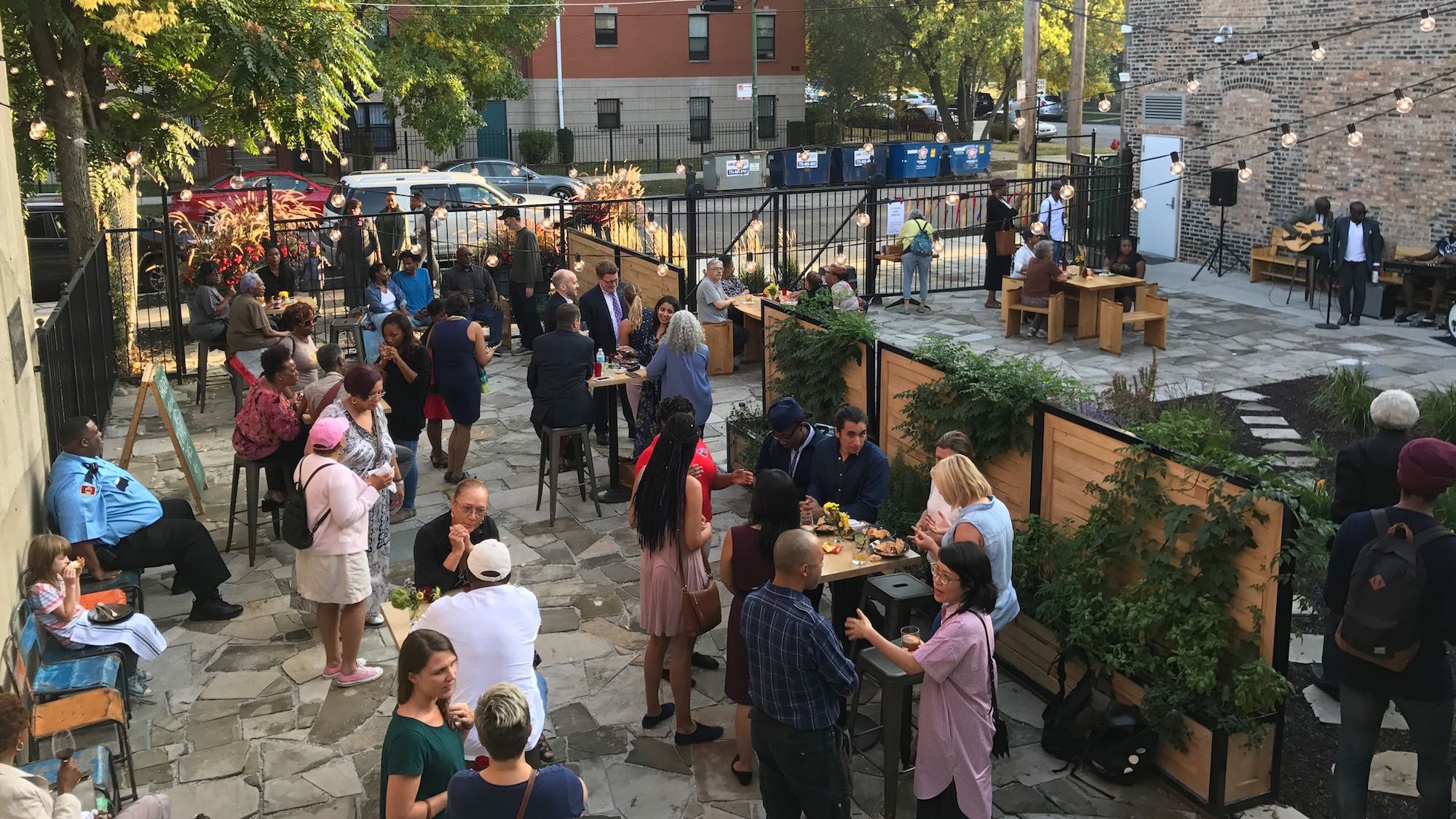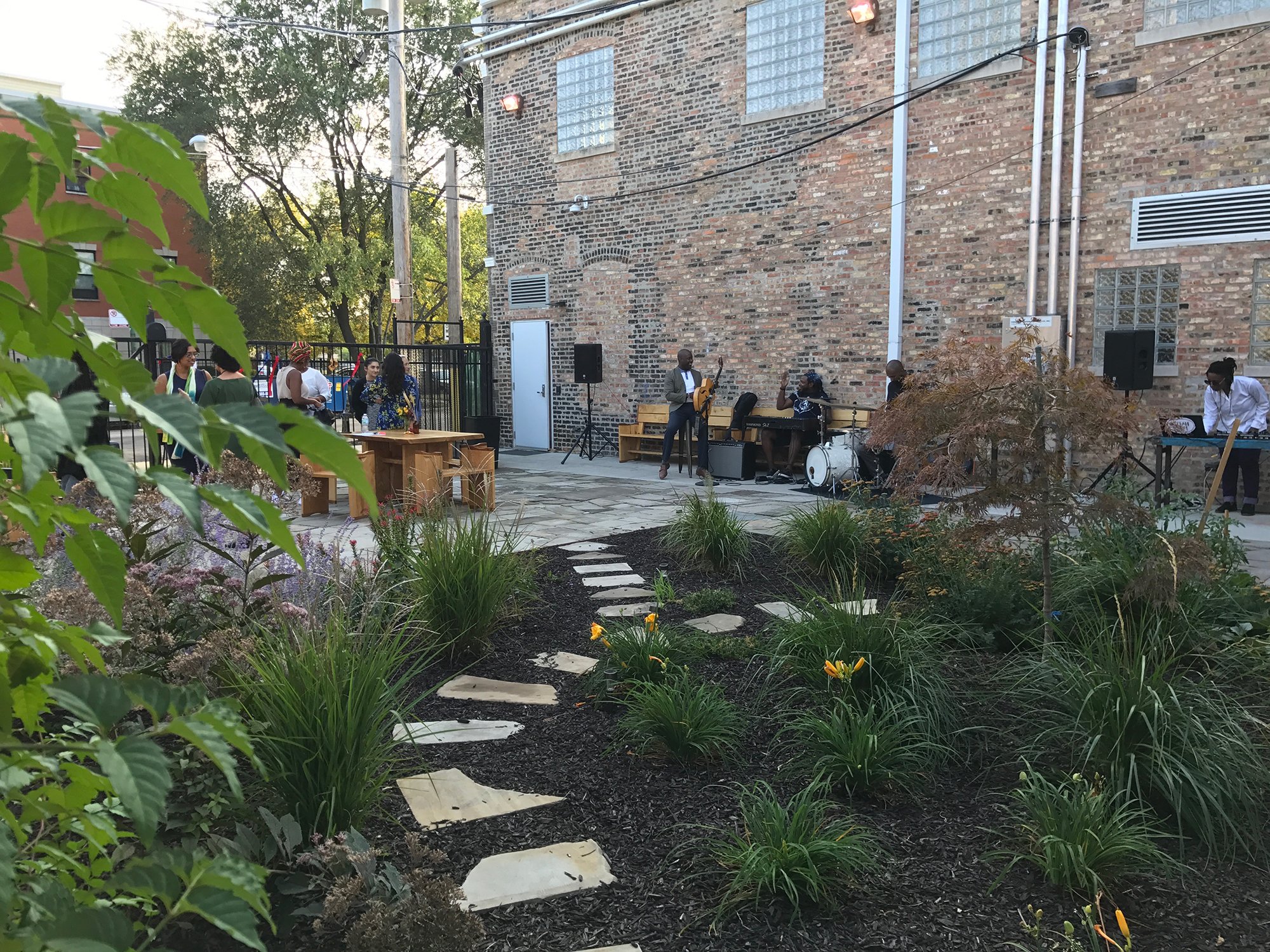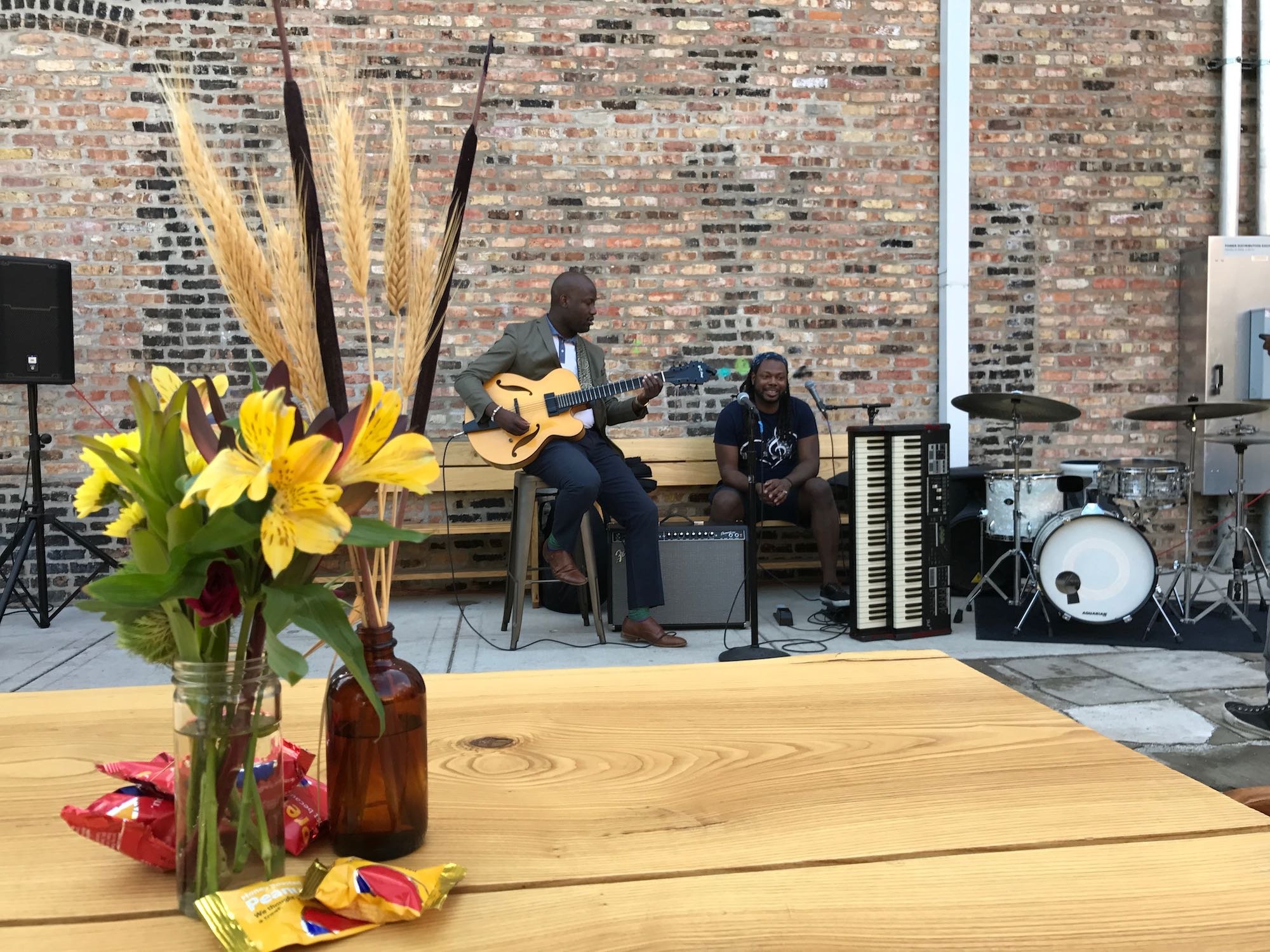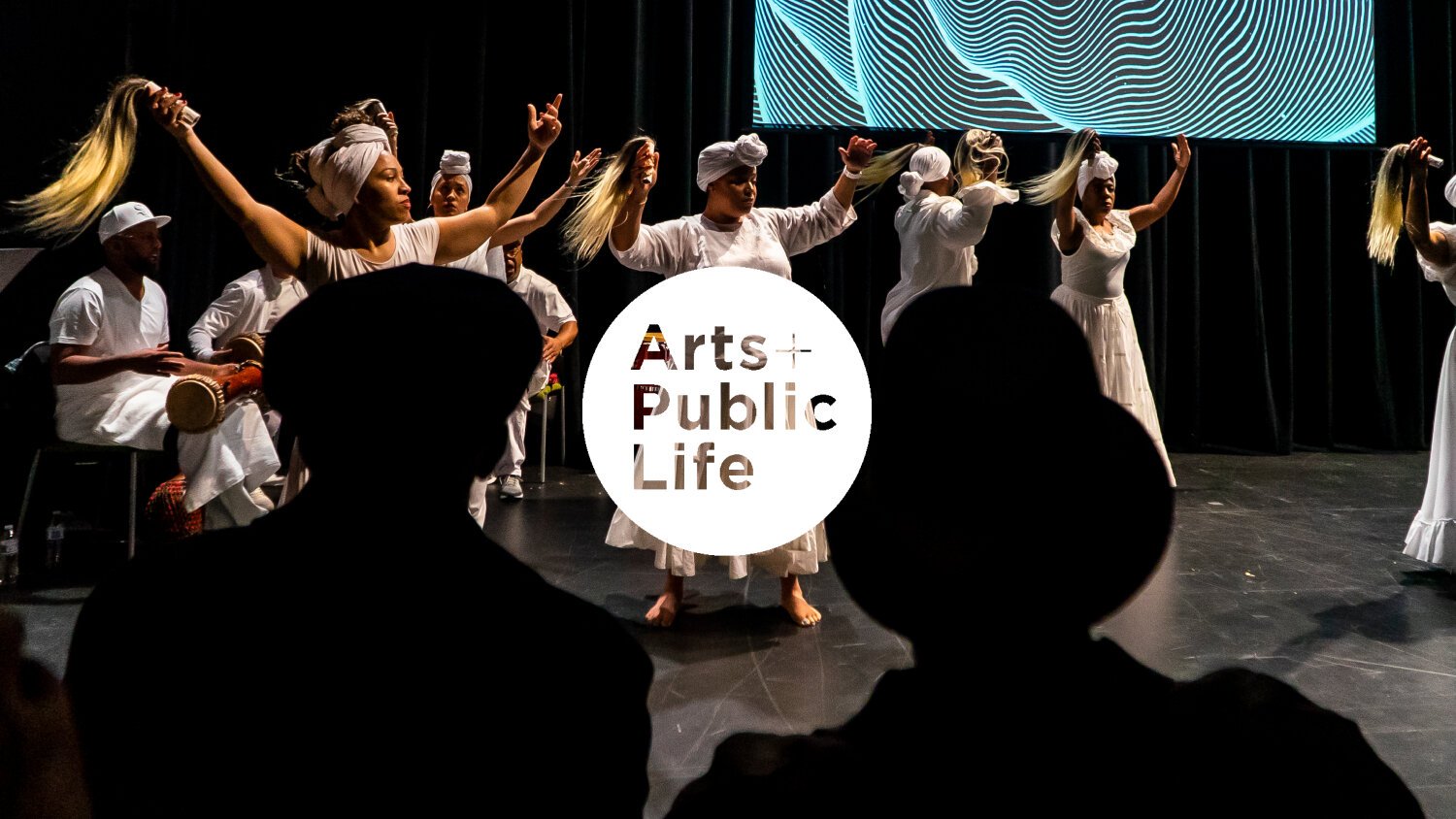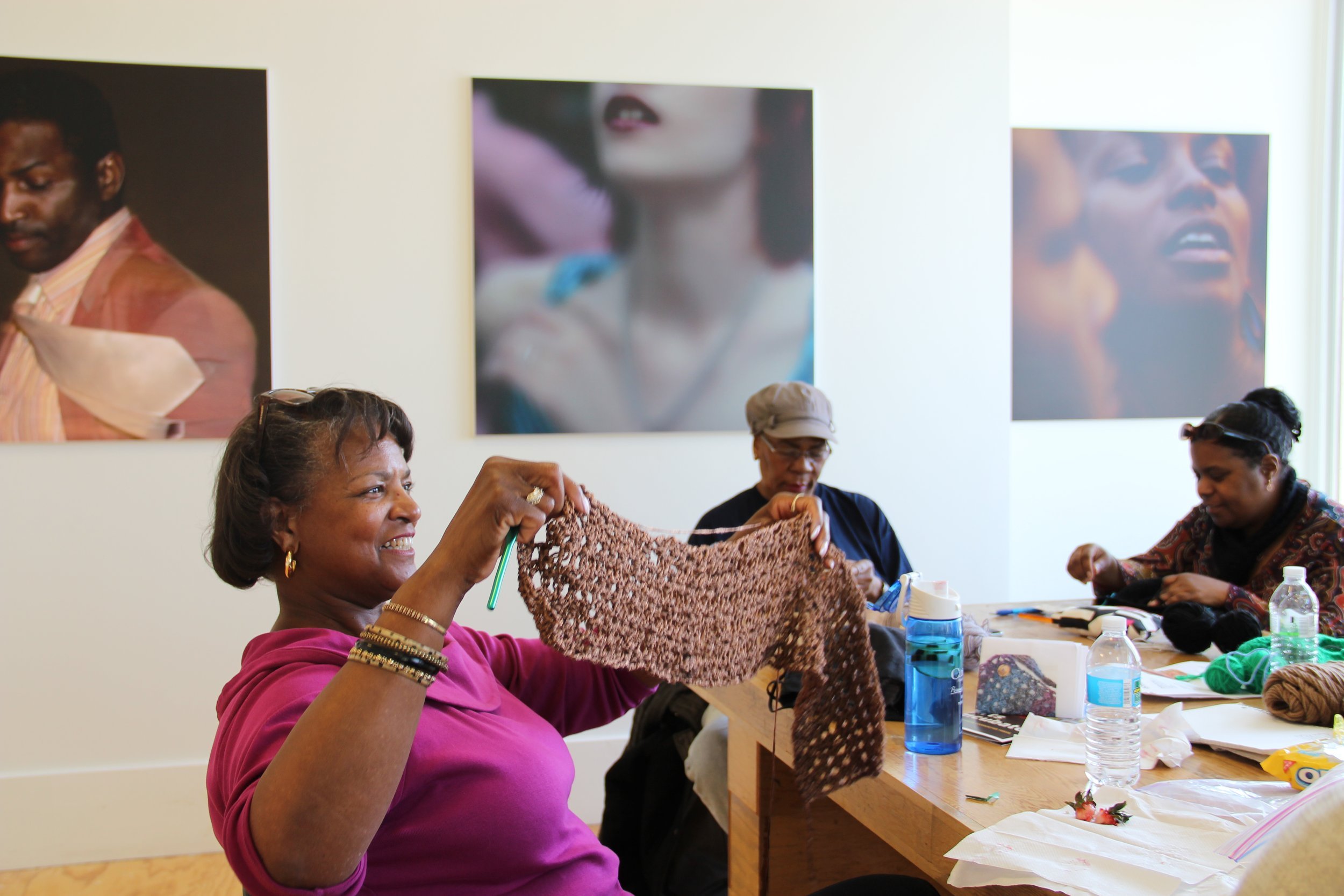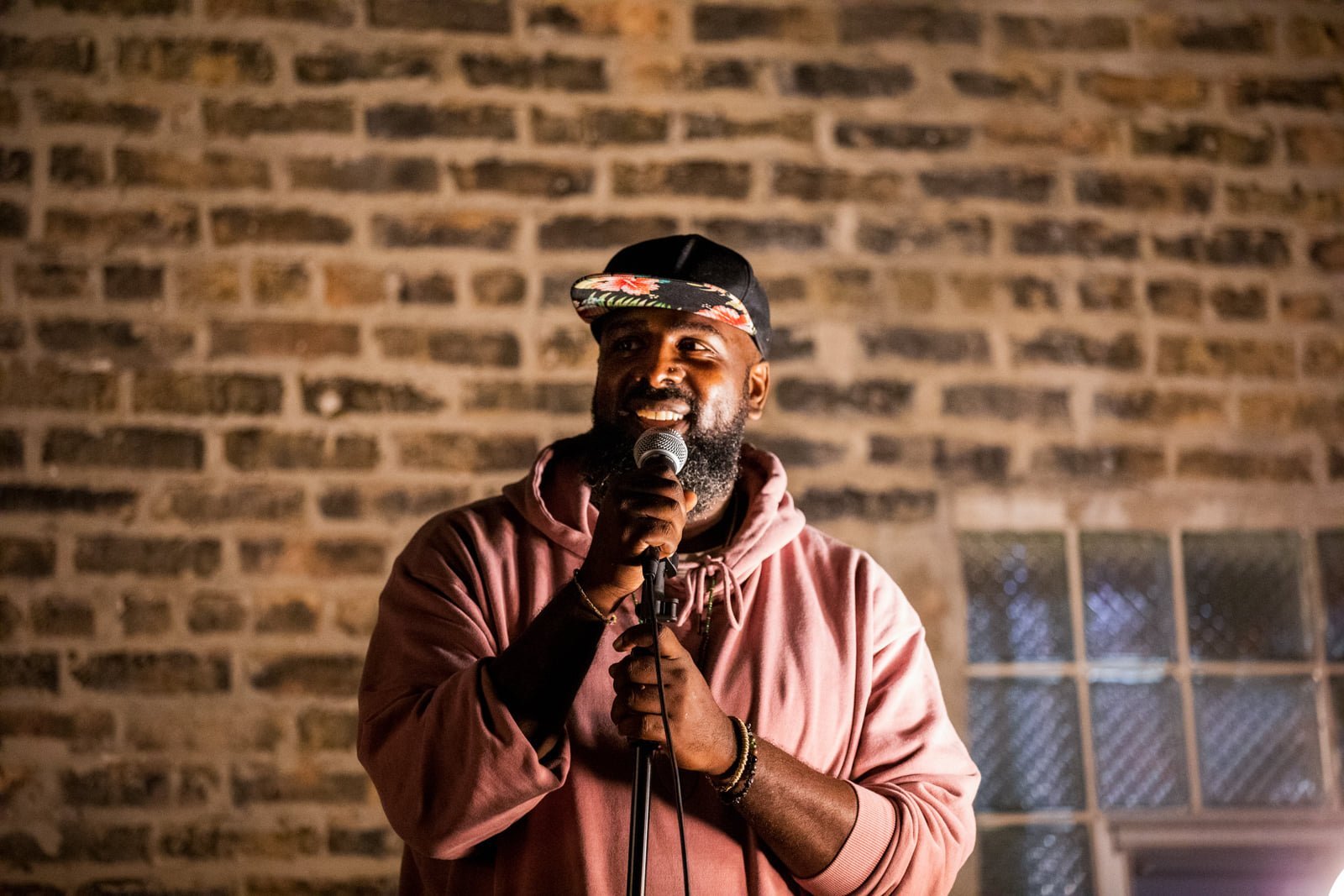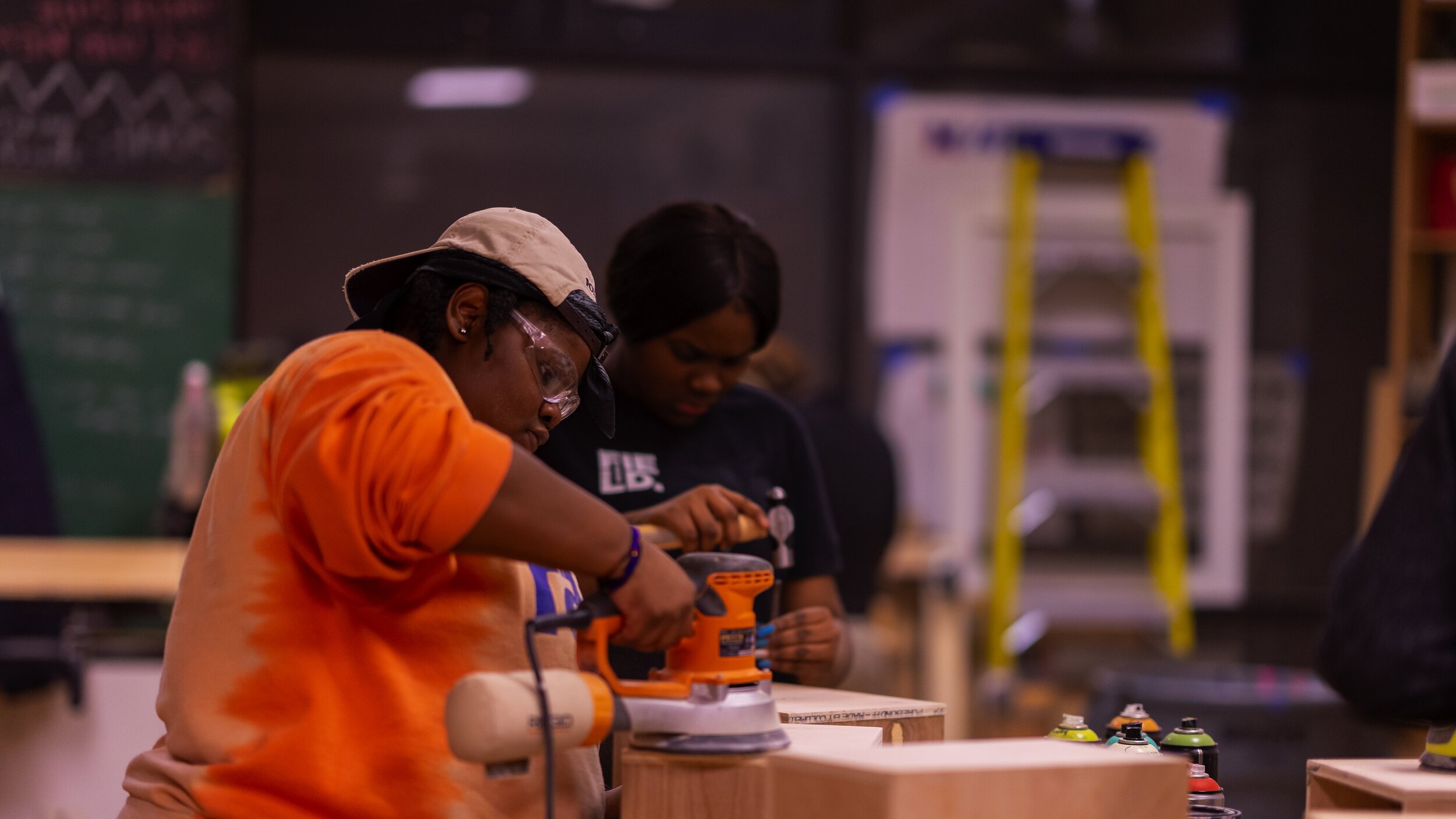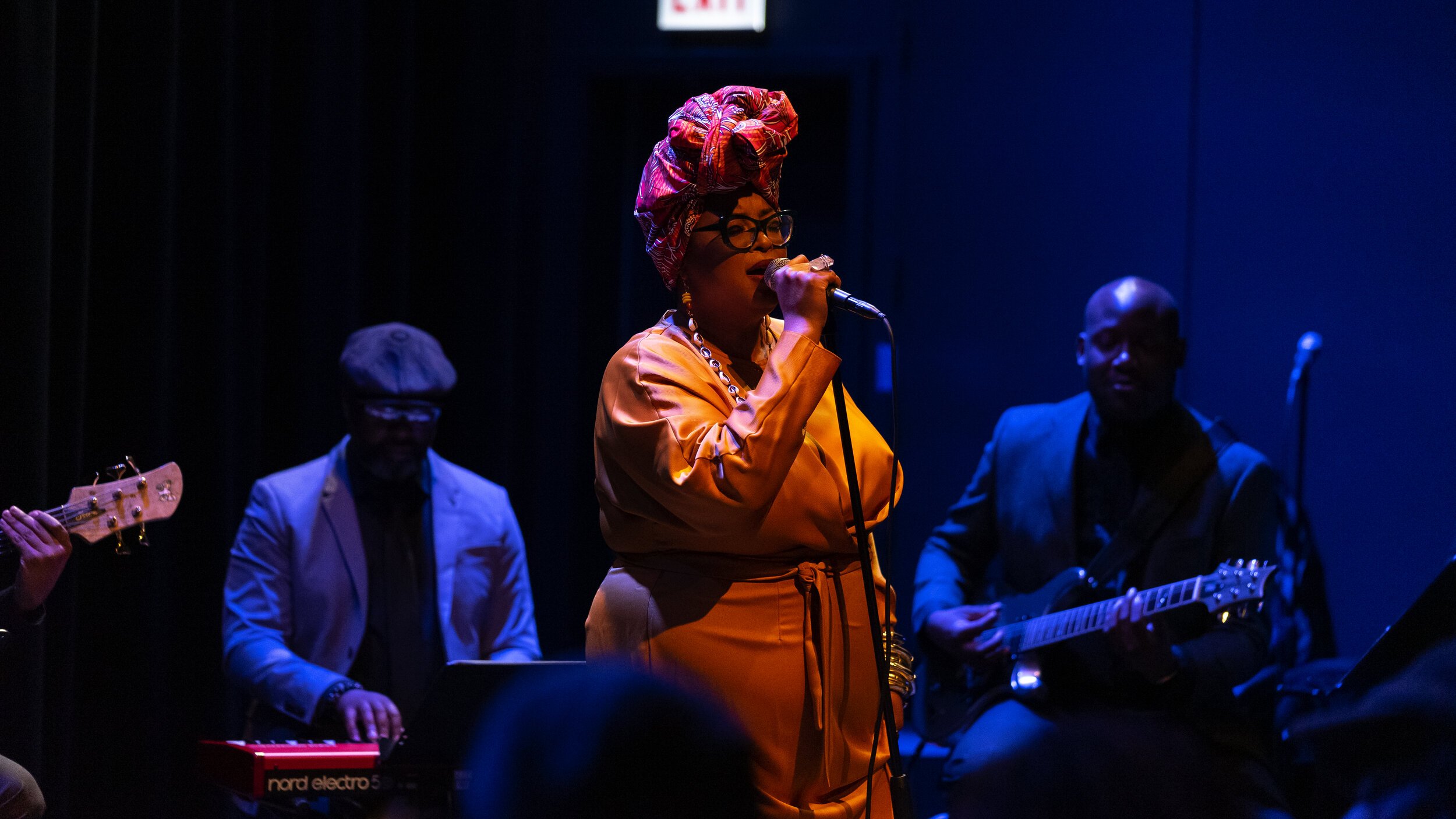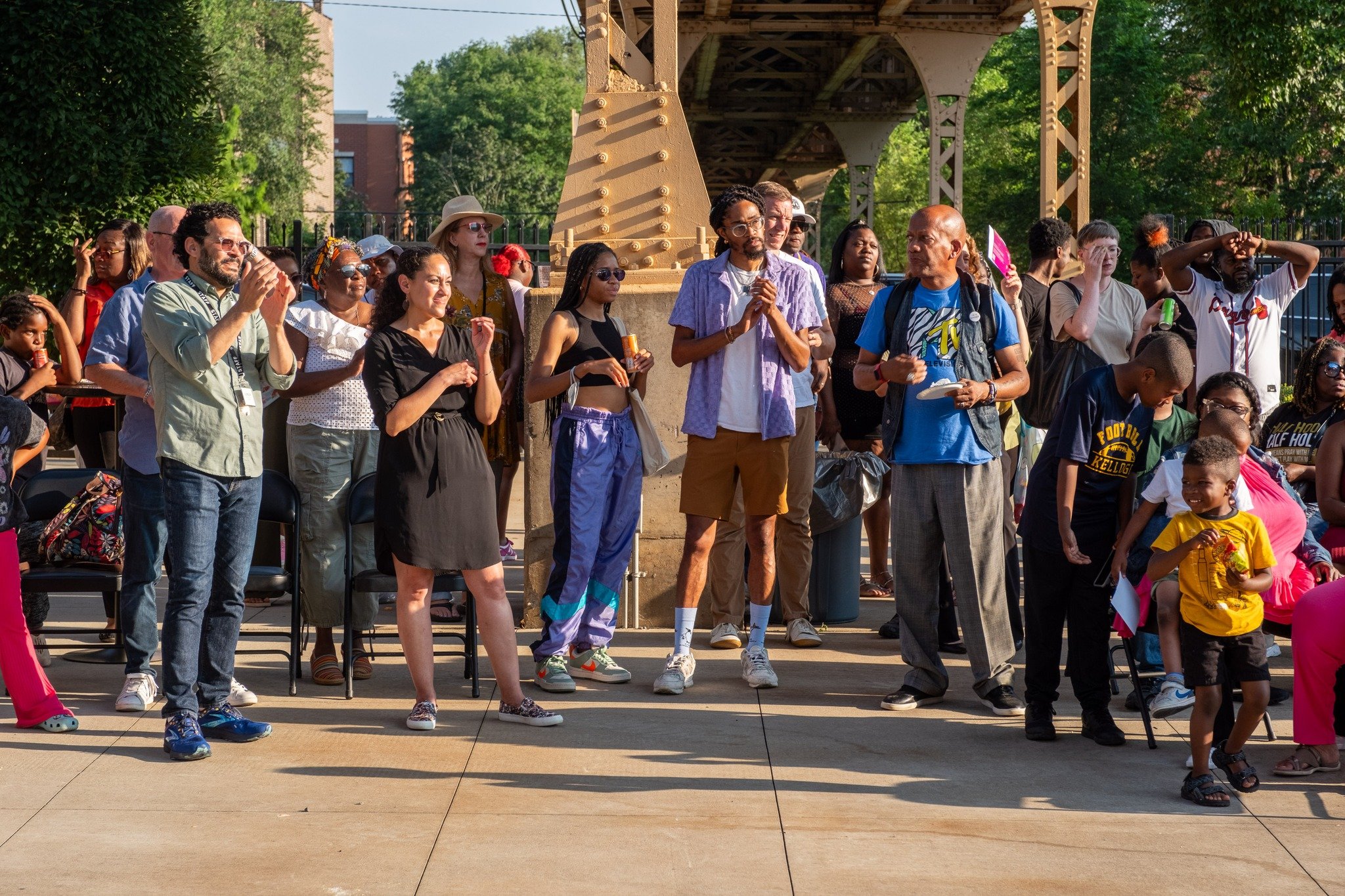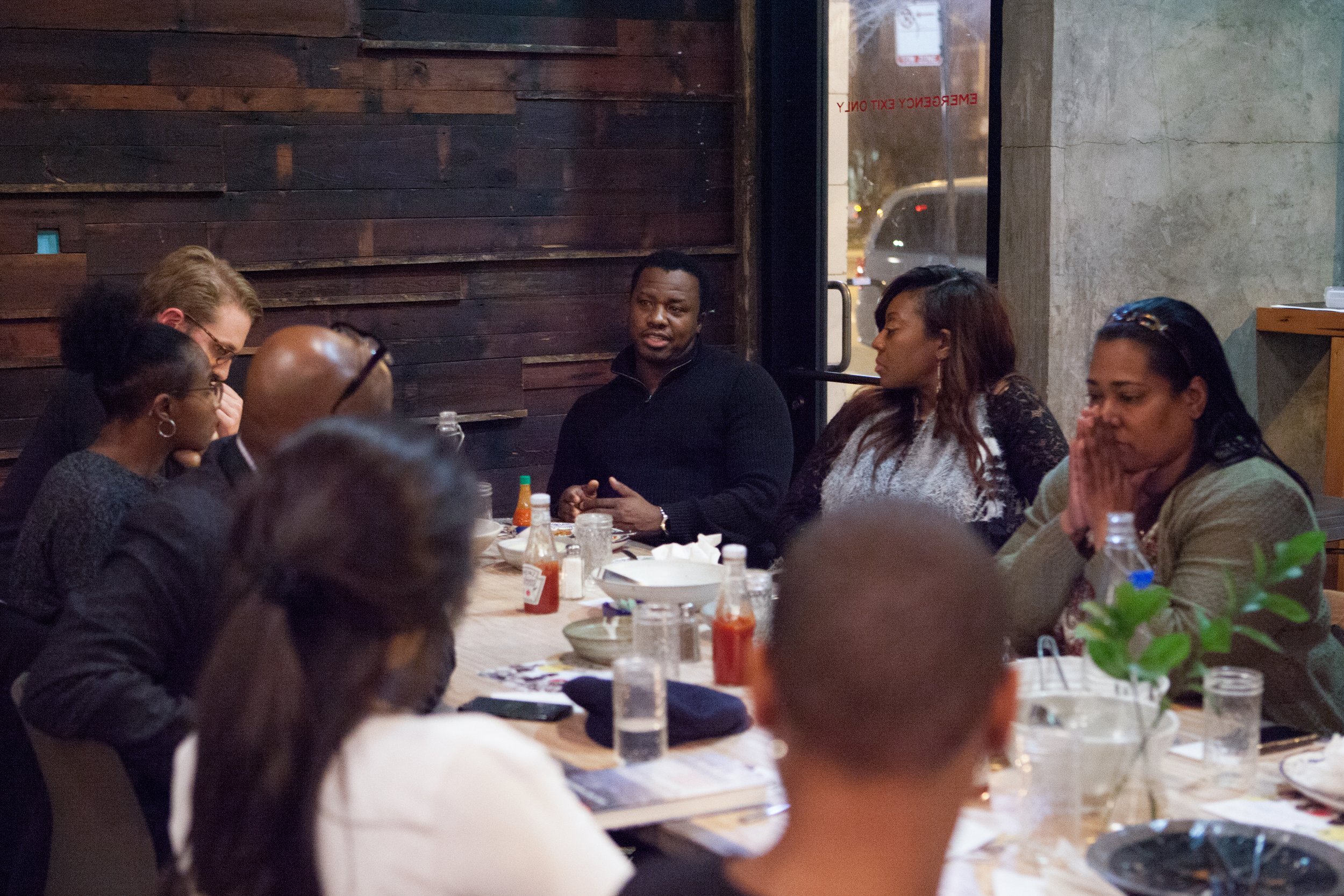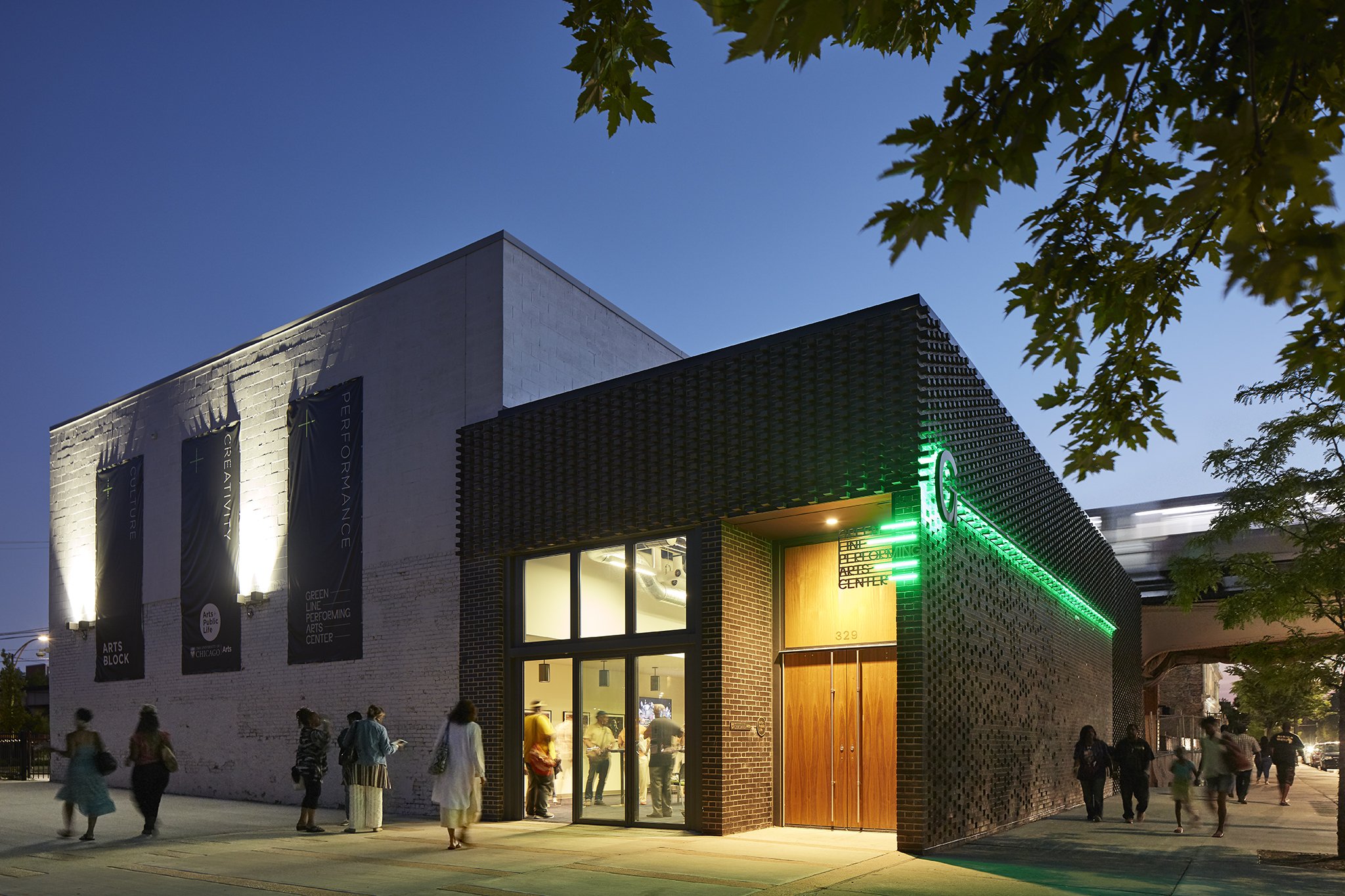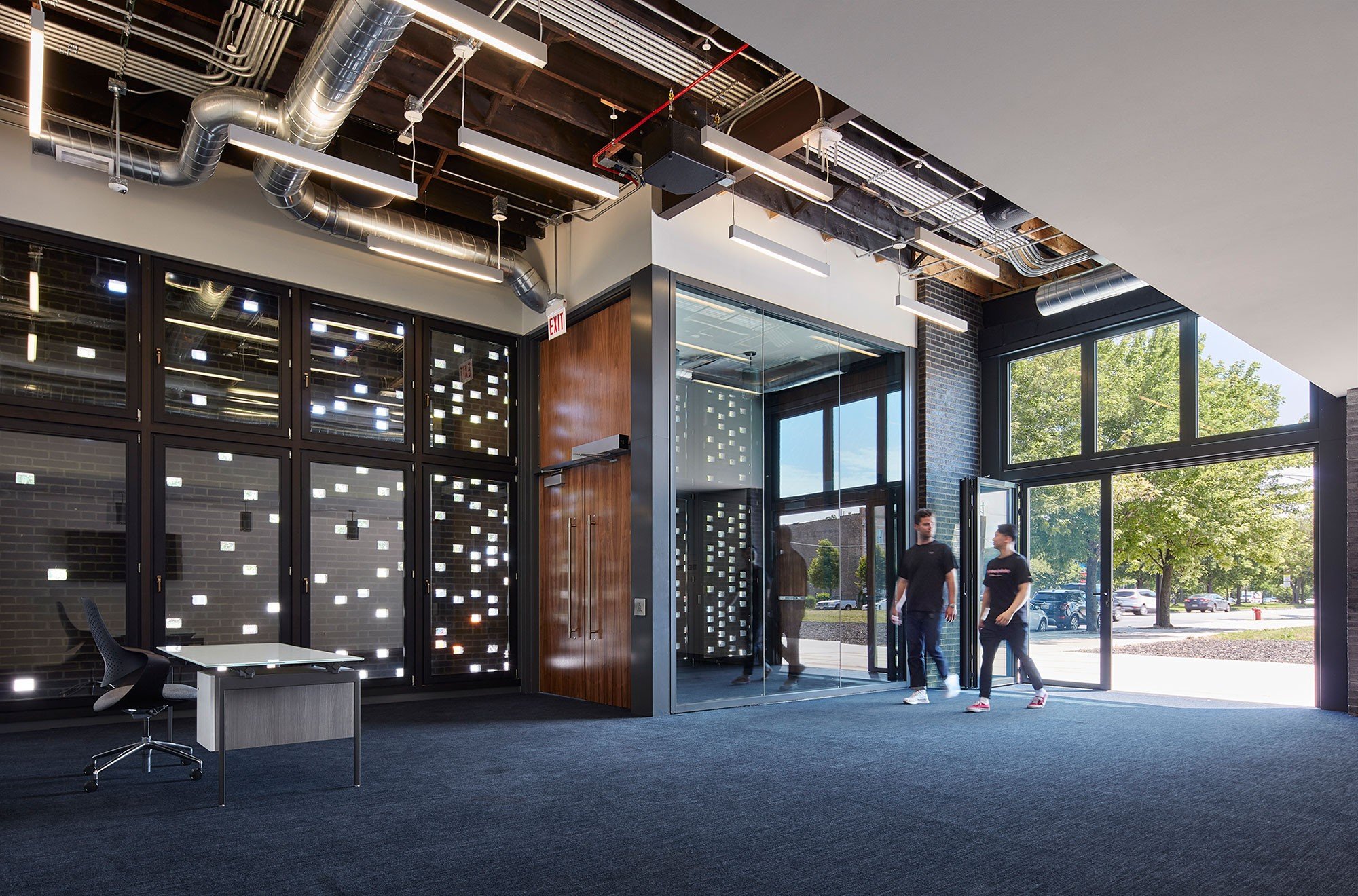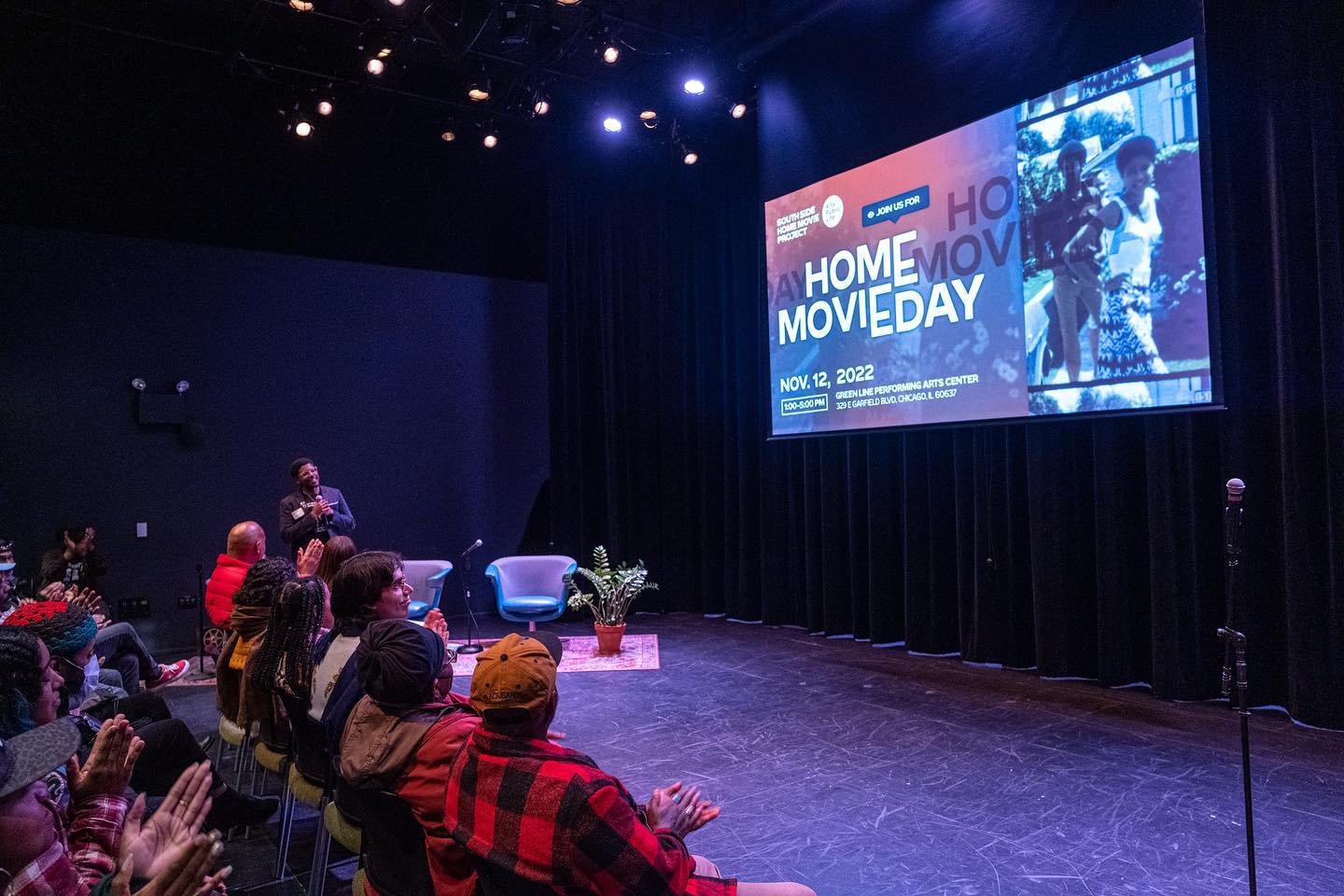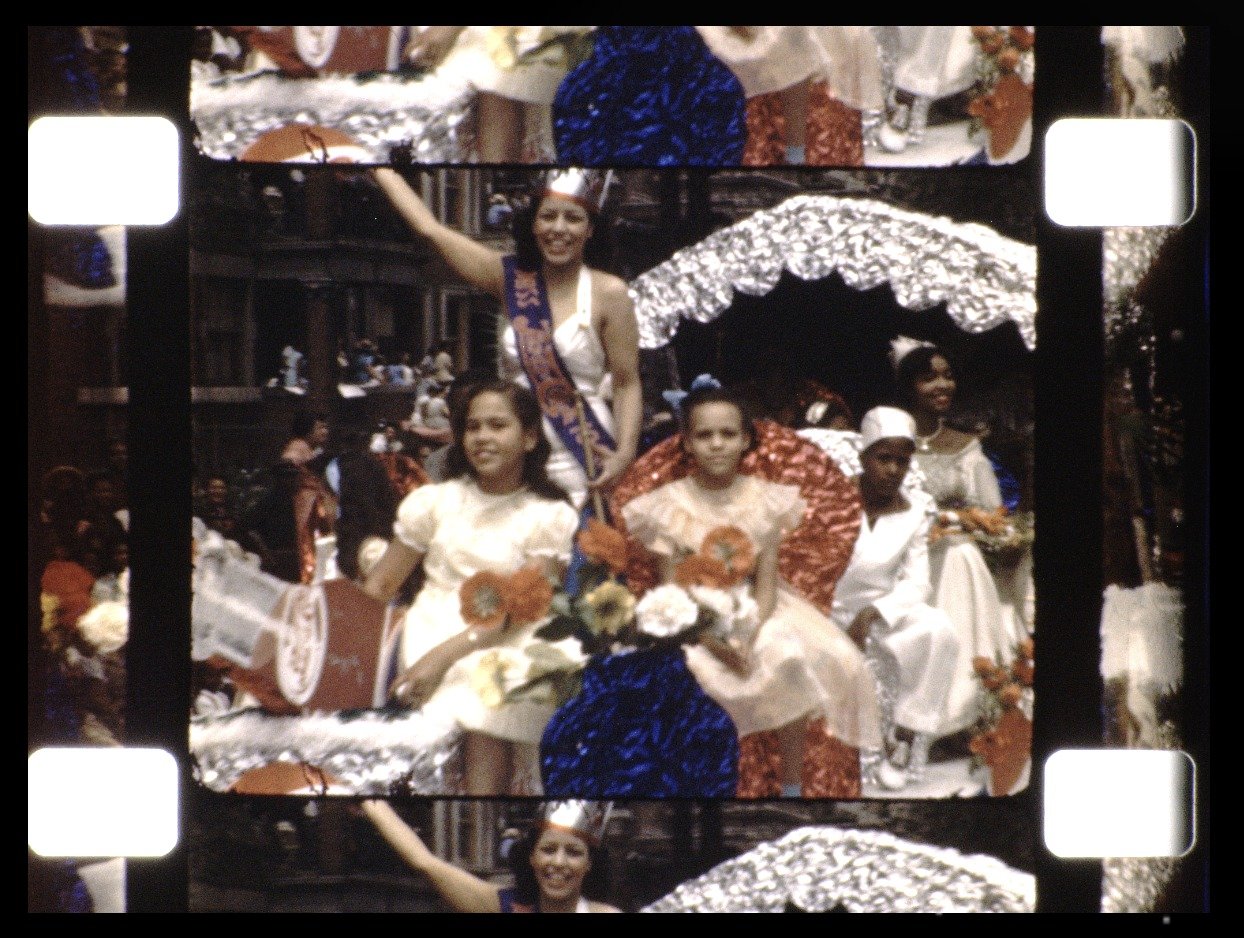Lush. Green. Public.
Arts + Public Life Launches Ambitious New Arts Block Experience: The Arts Lawn
The Arts Lawn on the Arts Block, looking west. Photo: Simeon Frierson
by Ellen Wiese
Ten years ago, Arts + Public Life at the University of Chicago began its stewardship of the Arts Block on Garfield Boulevard in Washington Park. Now, the launch of its Arts Lawn marks a new step in community-centered artistic space. Occupying a set of formerly undeveloped lots next to the Green Line Performing Arts Center, the Arts Lawn is an opportunity for the expansion of ambitious outdoor arts programming and community reclamation of public green space.
“The Arts Lawn is a testament to our commitment to supporting the cultural fabric of Washington Park.”
—Adrienne Brown, Arts + Public Life Director, from the Arts Lawn Press Release
Drone footage of the Arts Lawn. Videographer: Simeon Frierson.
What is the Arts Lawn?
Initial planning for the Arts Block—a collection of commercial and cultural spaces managed by Arts + Public Life along the 300 East block of Garfield Boulevard —centered a series of conversations between community partners, UChicago officials, practicing artists, and city representatives. “The idea of having outdoor space dedicated to the arts really originated in those processes,” says Nootan Bharani, the Associate Director of Cultural Stewardship and University Partnerships for Arts + Public Life (APL). “A thread that was continuous throughout, and in the actual master plan, is that there would be outdoor open space accessible to the community.”
Scientific research (including a recent study co-authored by an international group of researchers, environmentalists, and academics, including Marc G. Berman, director of UChicago’s Environmental Neuroscience Lab) has shown that interacting with green space leads to better health and wellness outcomes. But the Arts Lawn isn’t just a park. It’s designed to serve a multitude of purposes, from solo reflection to dance performances to pop-up shops to film screenings. “This is a University and city investment in Washington Park, because Washington Park deserves to have civic assets just as the rest of Chicago does,” says Isis Ferguson, APL’s Senior Director of Engagement and Partnerships. “This is a site that supports and underscores and creates connectivity. This is what communities deserve—we deserve green spaces, we deserve art spaces.”
The Arts Lawn aims to create a community hub while honoring and continuing to build the history of Garfield Park and Washington Park. “It connects to the legacy of cultural production that has always existed on this corridor and in this neighborhood,” says Ferguson. As the Arts Block has come into being through community conversations, APL has sought to remember the spaces that preceded it. “All of our spaces are tied to understanding the history,” says Bharani. “That’s something that we hope to make even more accessible as time goes on—to really remember the spaces that came before us, and celebrate the legacy and the people as we’ve found folks who have been part of these spaces in the past.”
At its core, the Arts Lawn is about accessibility. “One of our tenets, our specific values for bringing about the development of all of our spaces, is accessibility and invitation,” Bharani says. “Bringing the programming and events to the Arts Lawn and outdoors is yet another intentional removal of barriers. It’s another encouragement for folks to join in.”
“We drink in nature, we yearn to commune with the beautiful, we crave the sublime...”
—Theaster Gates, Founder of Arts + Public Life, in his TED Talk “How to revive a neighborhood: with imagination, beauty, and art”
Activating Outdoor Space
“Arts programming is the heart of our community engagement,” says Bharani. “That’s where we learn, understand, and have truly authentic engagement with everybody that’s coming to our events.” Since its launch in 2018, the Lawn’s neighboring Green Line Performing Arts Center has been hosting a full roster of events and programs, but due to their comparatively limited space, they are often at capacity. The outdoor space on the Arts Lawn will allow for larger and more flexible public offerings.
However, the Arts Lawn won’t be operating at full capacity right away. APL plans to introduce programming over several years in a phased approach that will enable a thoughtful assessment of the best way of utilizing the space. While the Arts Lawn is a huge programming opportunity, it also poses its share of challenges—contending with the sound of traffic during performances, for example (the Garfield Green Line station is across the street, and the train itself runs next to the Green Line Performing Arts Center).
Initially, APL will build and explore the capacity of the Arts Lawn by extending existing programming. “We’re planning on a continuation and evolution of our presence in the Green Line Performing Arts Center,” says Ferguson. “We’ll start by shifting some of the longstanding public programs that happen inside our buildings.” Teenagers participating in APL’s youth arts education programs will have the opportunity to meet outside for workshops and even showcase their work on the Arts Lawn.
Popular programs that may move outdoors include the Committed Knitters bi-weekly knitting and crocheting group and the weekly community yoga class. There are plans to shift installments of DJ and music historian Dwayne Powell’s Rear View Mirror Sessions and the First Monday Jazz series that particularly lend themselves to outdoor performance at the Arts Lawn. Like all of APL’s events, these will be free and open to the public.
Taking a deliberate approach to the expansion of outdoor programming will allow APL to tackle the challenges of opportunities of the space for programming, but it will also allow an assessment of the balance between specific events and general access. The Arts Lawn is intended to be both a programming space for a wide variety of arts events and a green space for the community. “The intention for the Arts Lawn isn’t just activity,” says Ferguson. “It’s also relaxation, quiet reflection, time in nature.”
Image grid above: Arts + Public Life’s Rain Garden, a green space on the Arts Block tailored for intimate, small events. Photos courtesy of Arts + Public Life. / Slideshow: Arts + Public Life program snapshots. Photos courtesy of Arts + Public Life.
“Justice is what ‘love’ looks like in public, just like tenderness is what ‘love’ feels like in private.”
—Dr. Cornel West
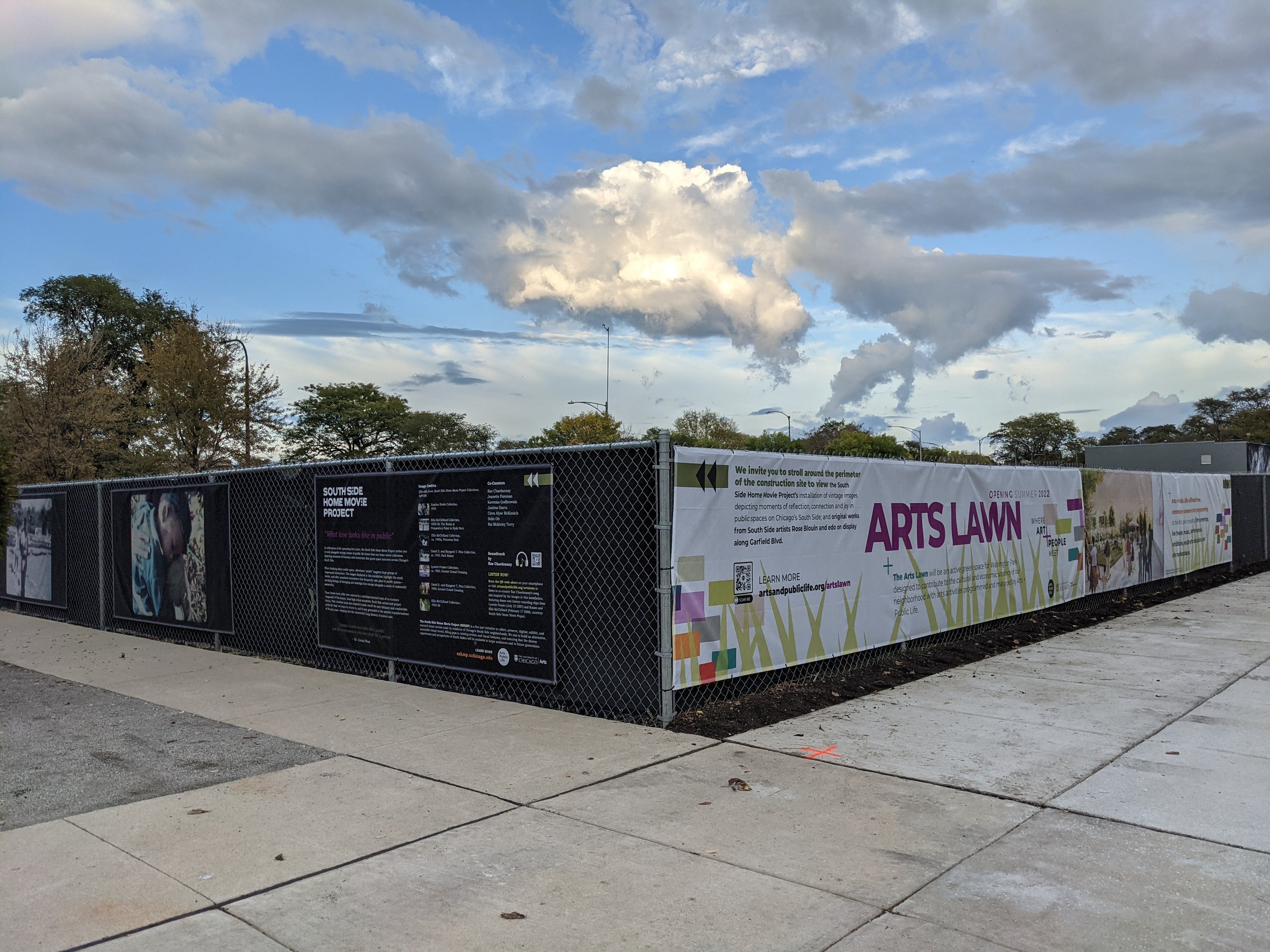
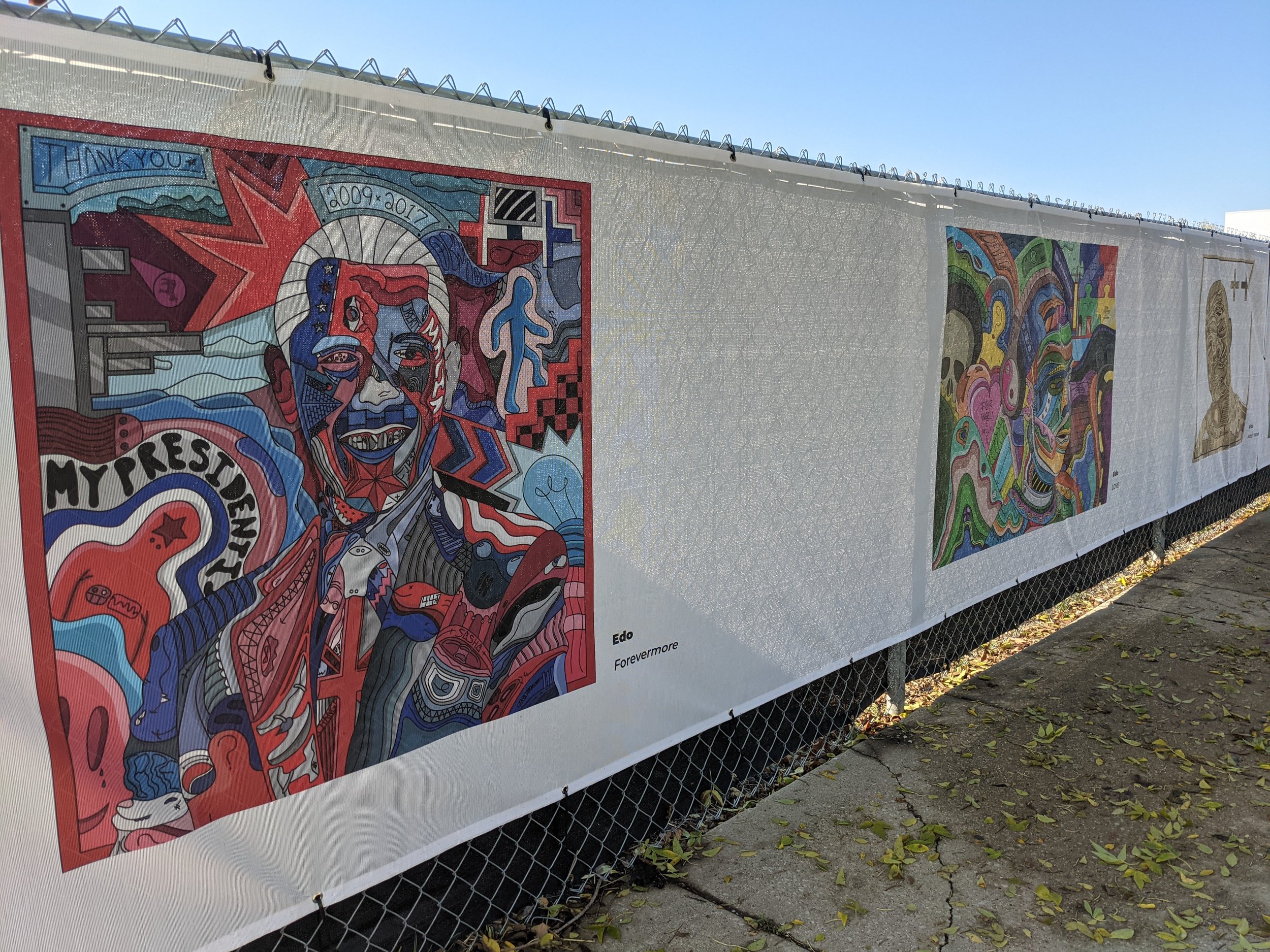
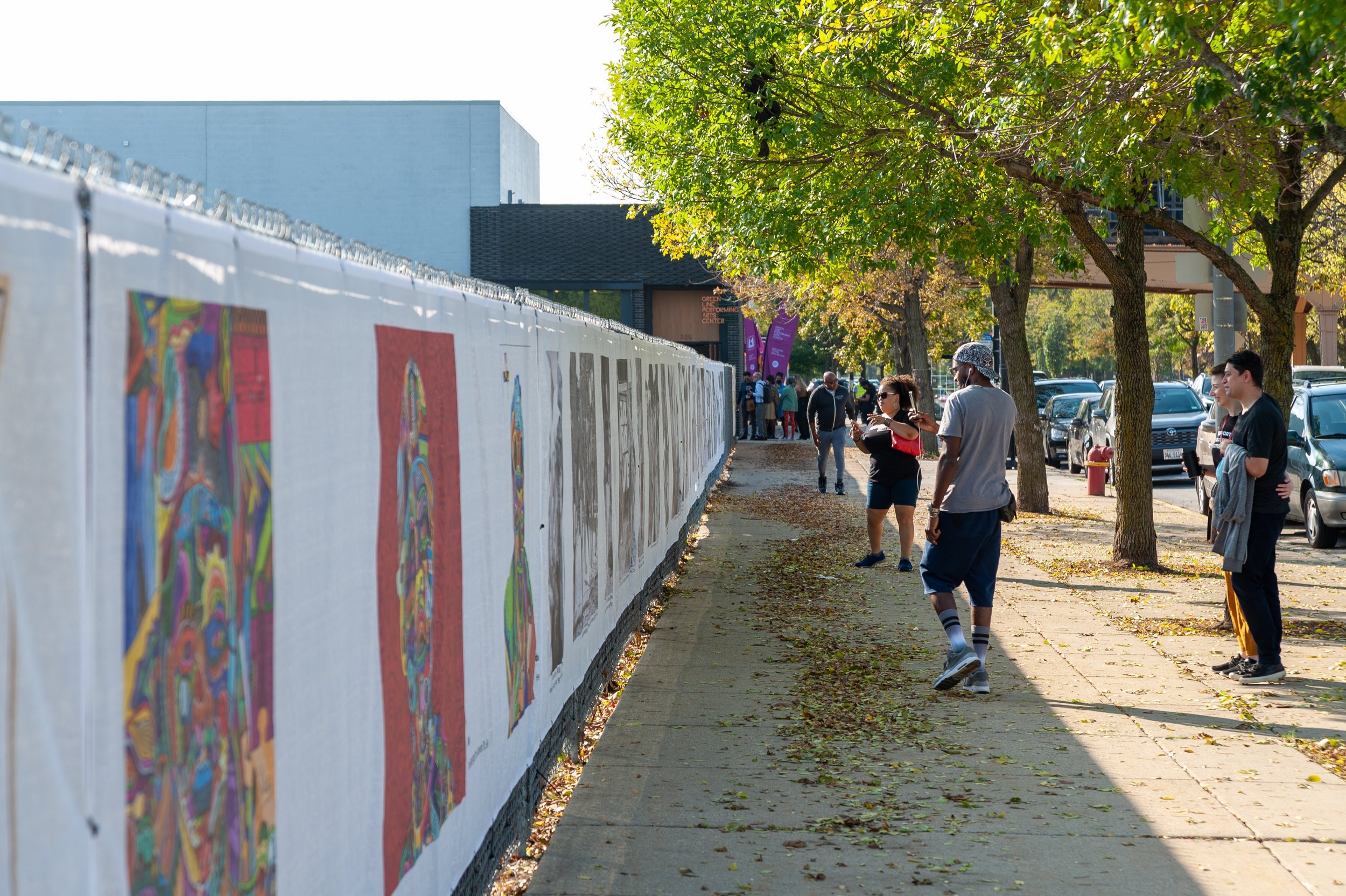
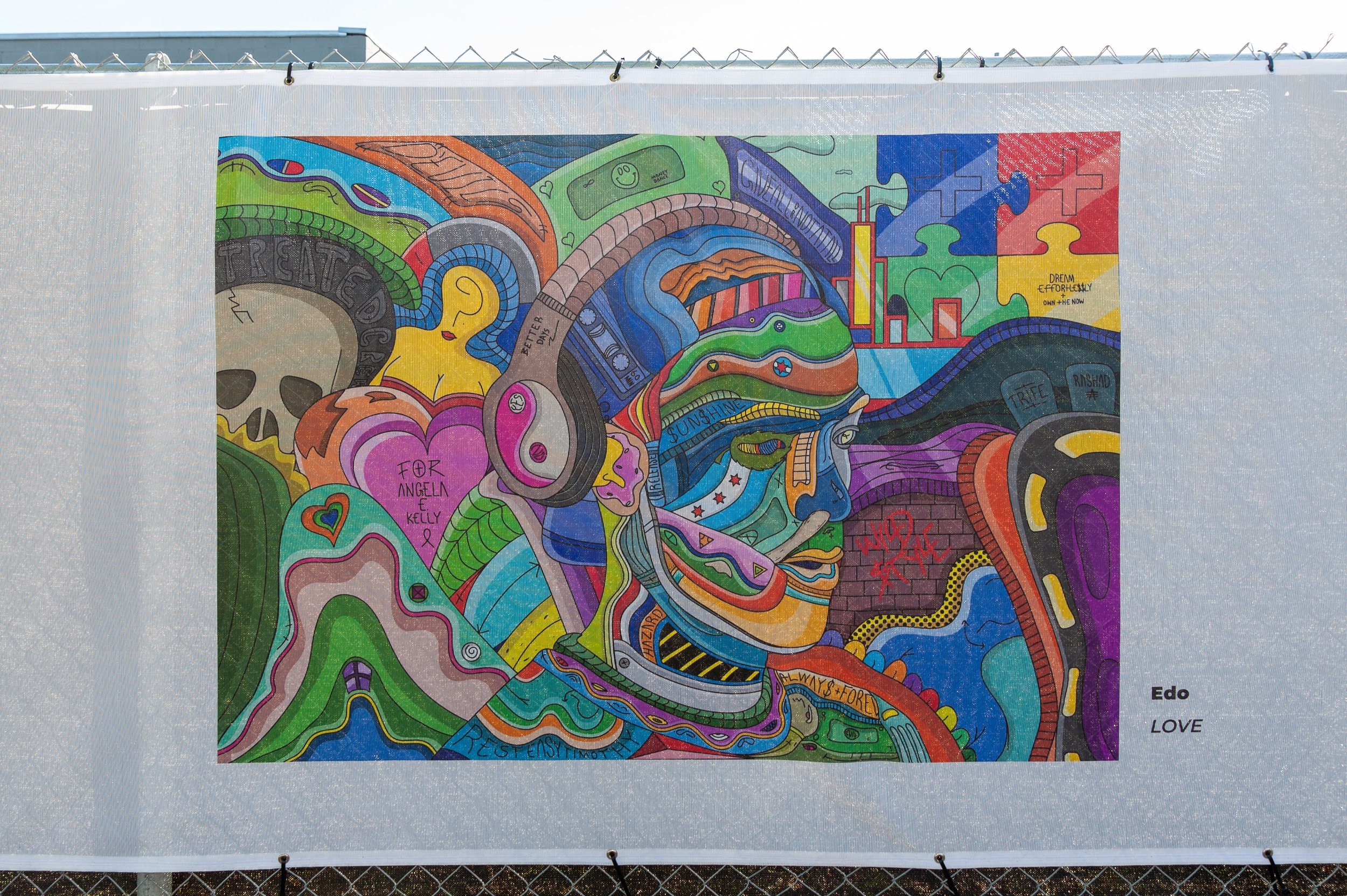
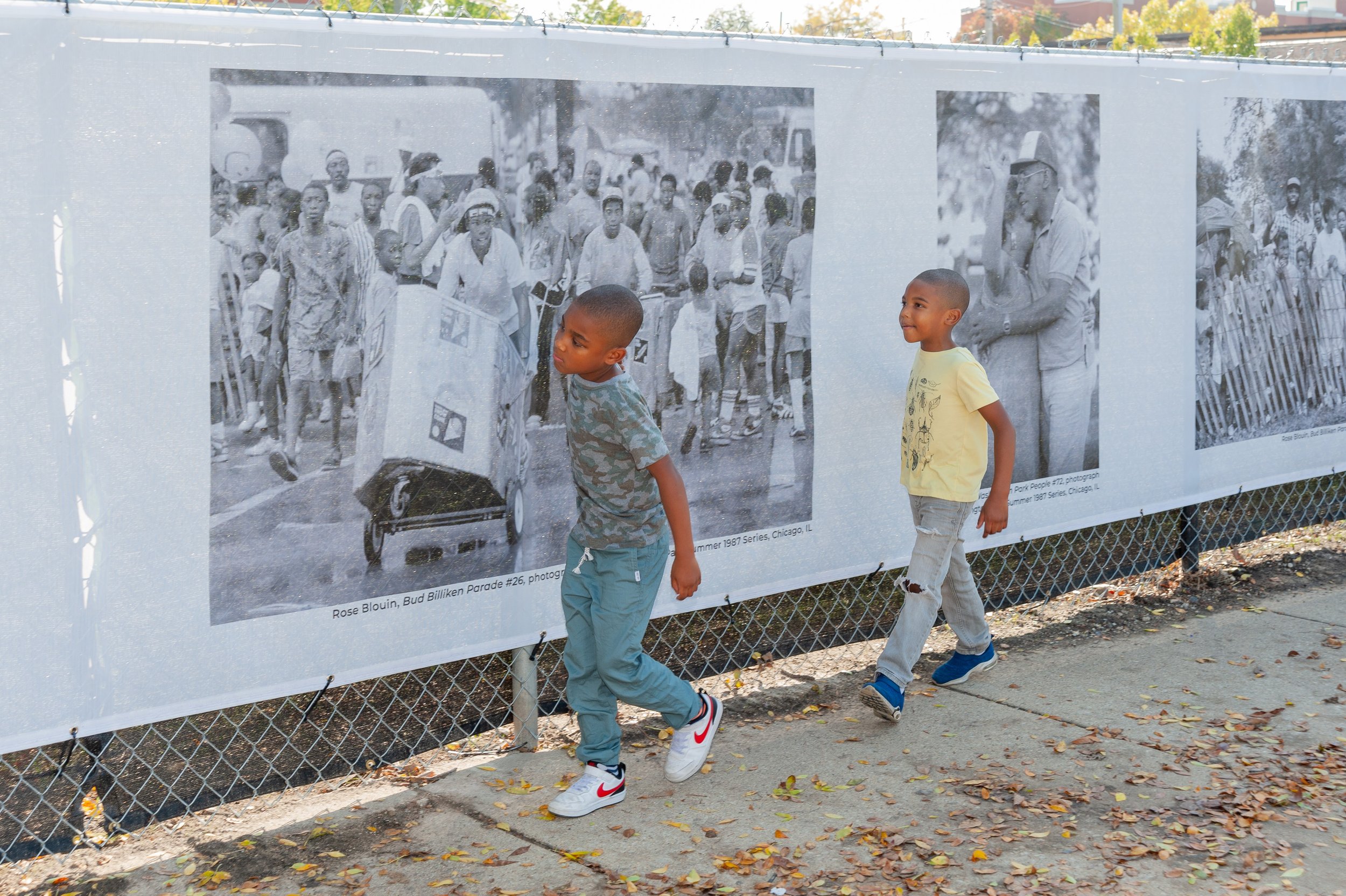
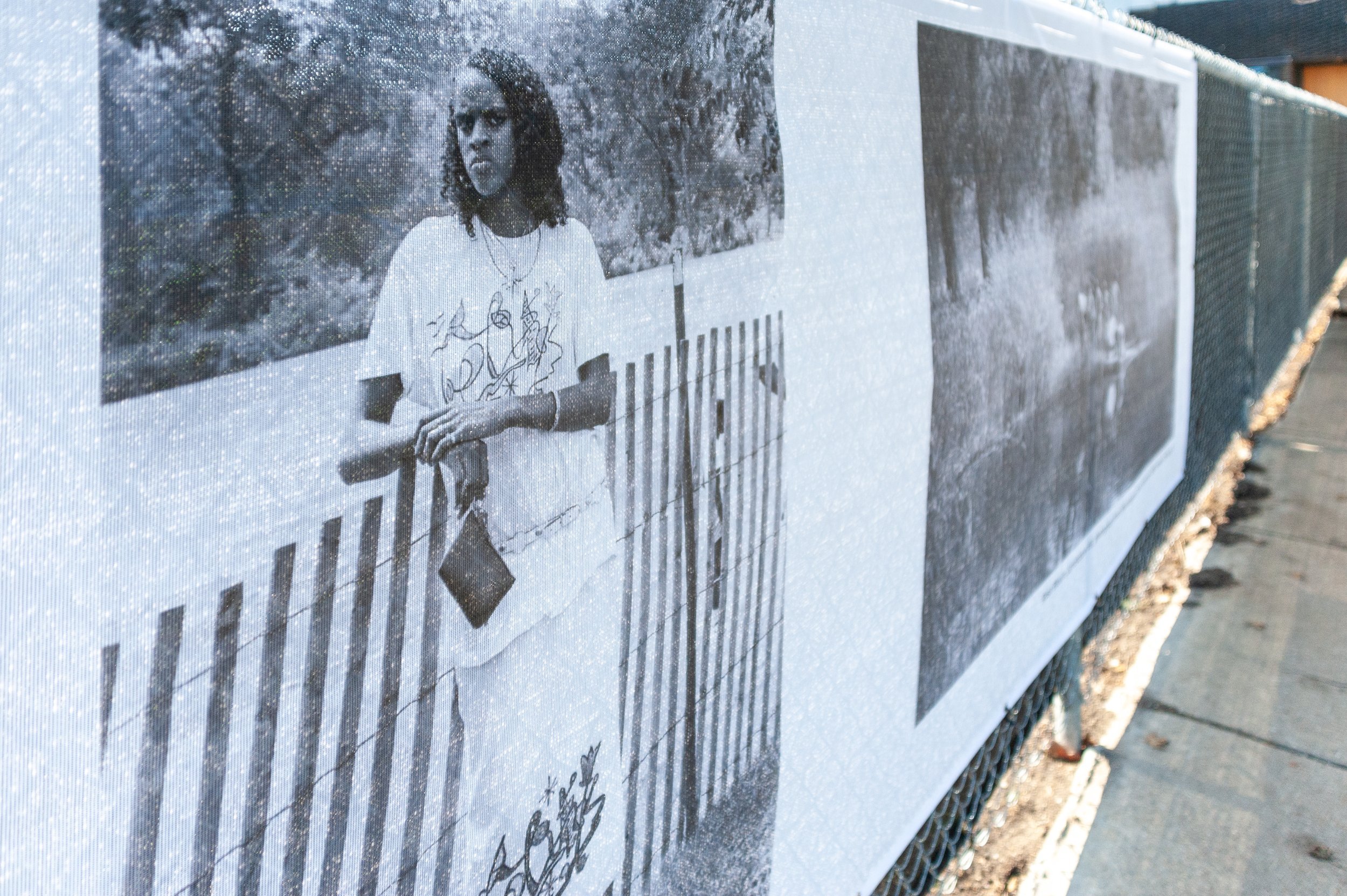
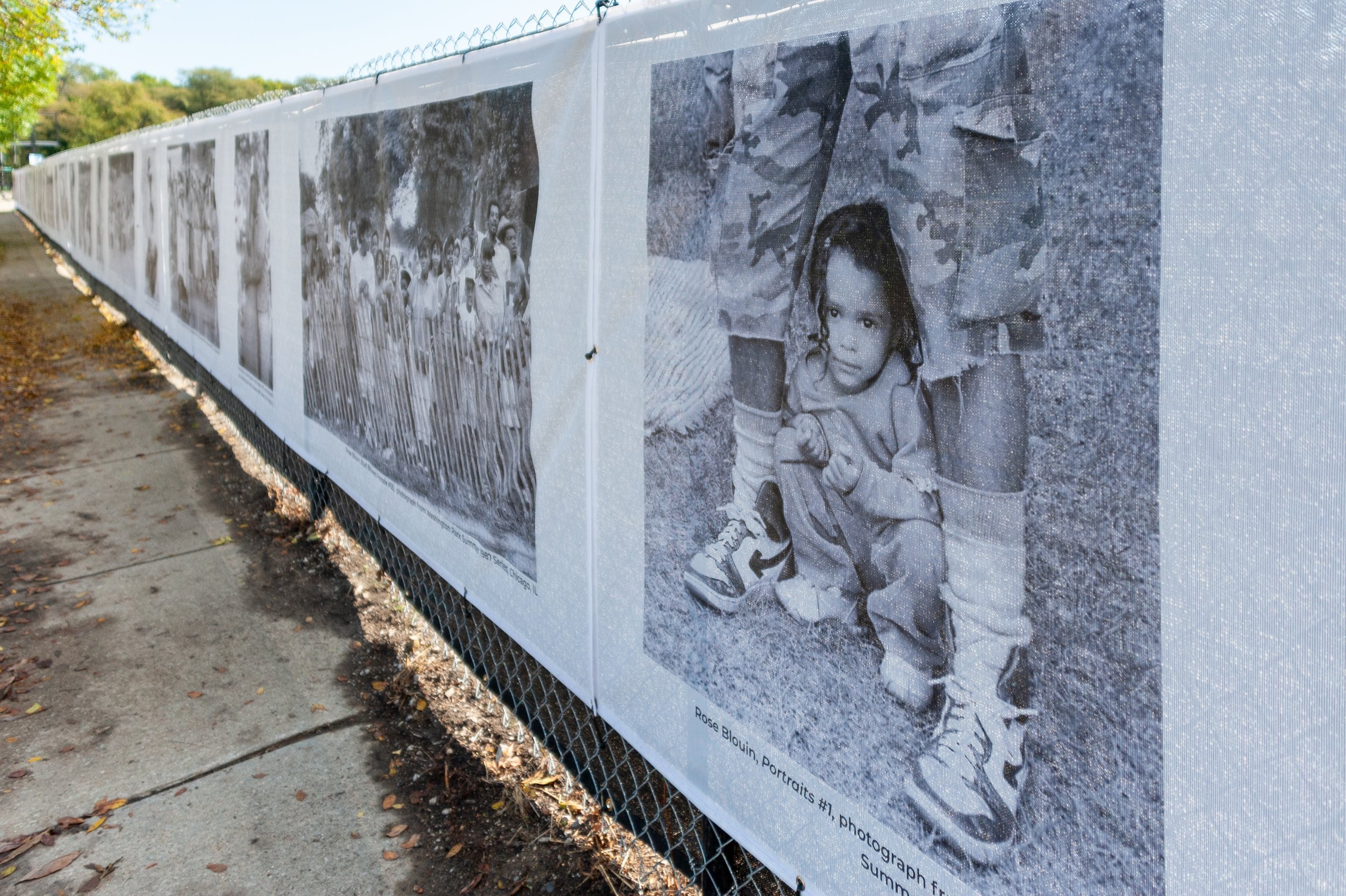
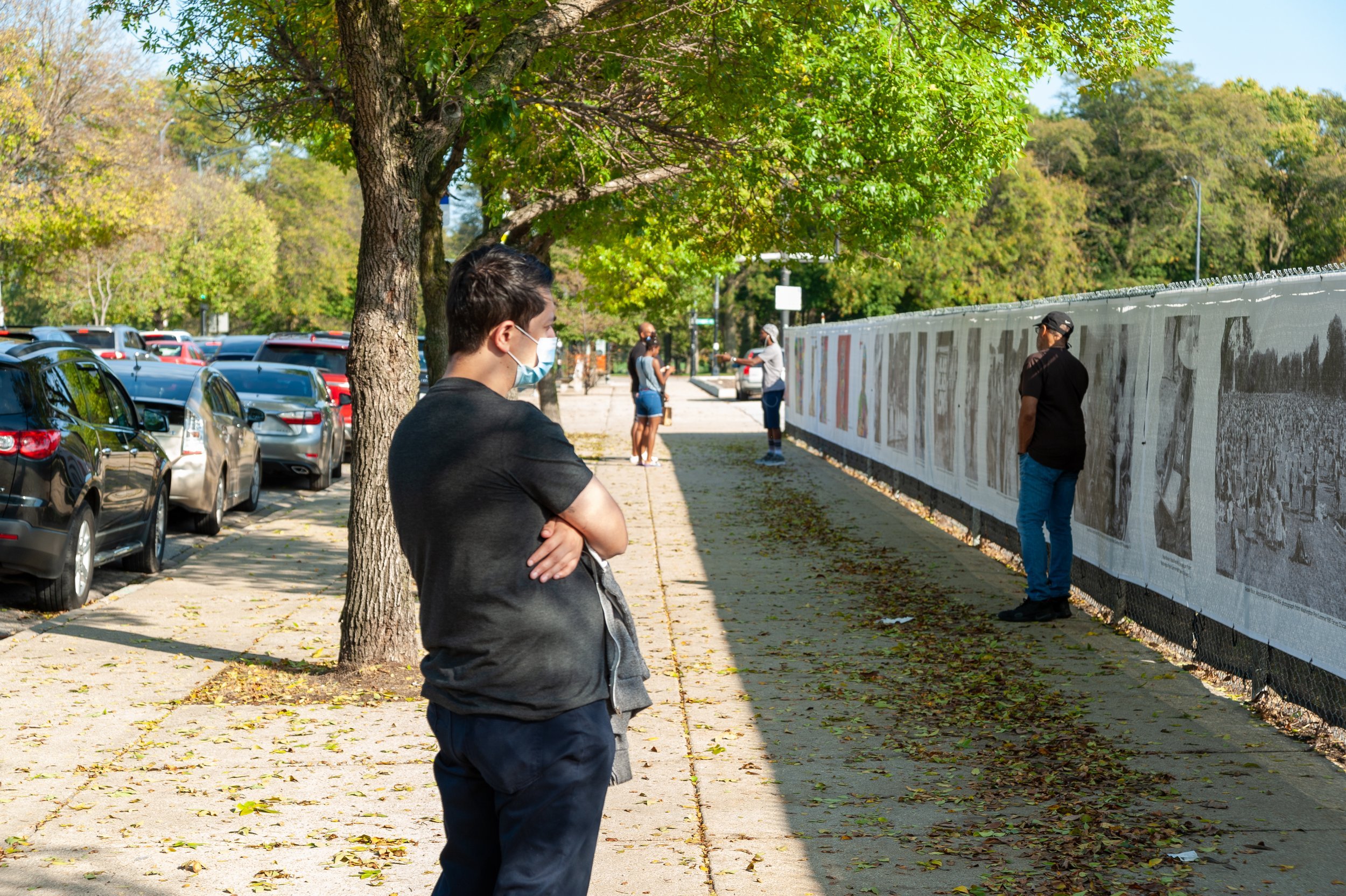
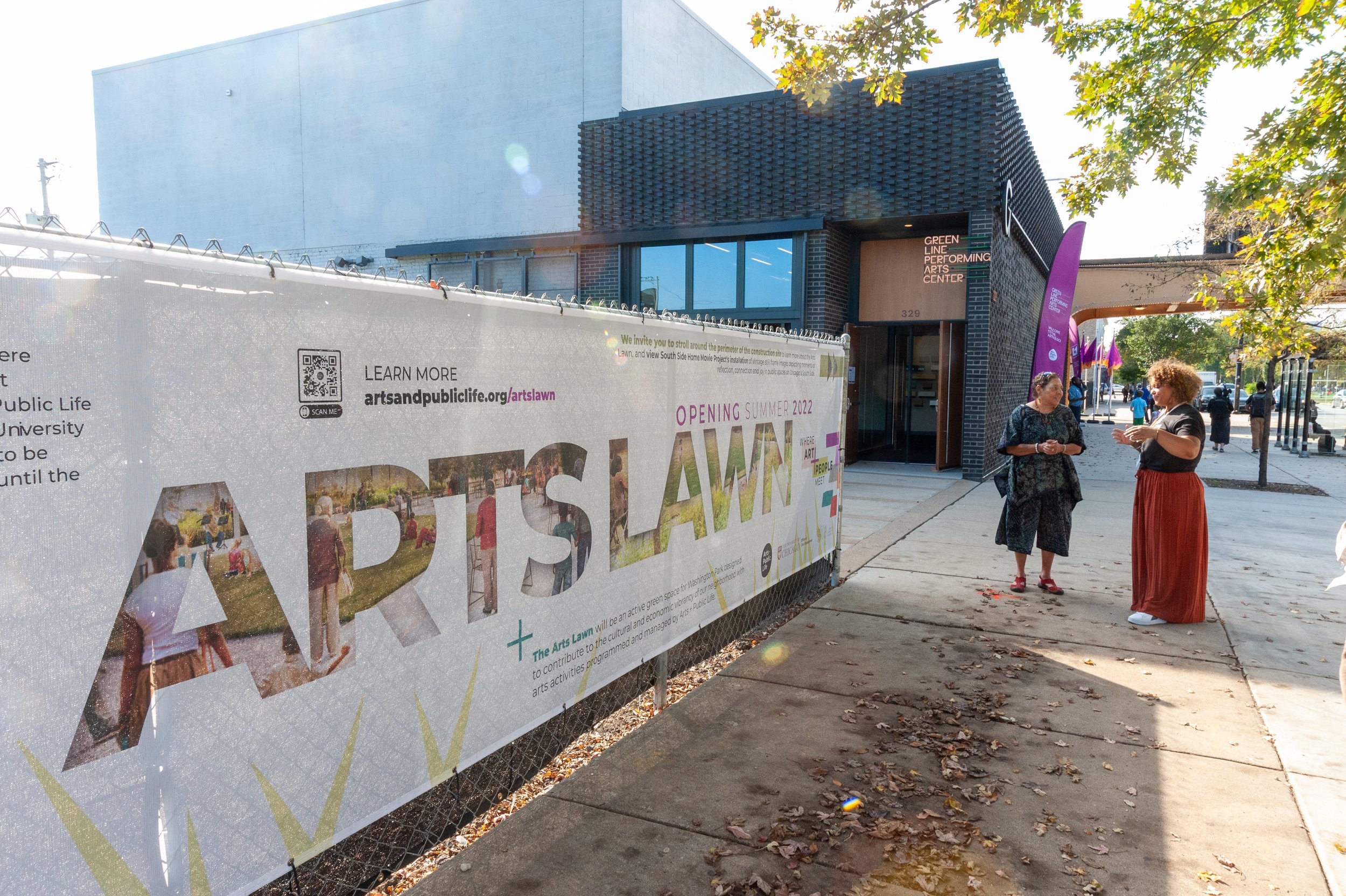
Constructing the Lawn
In 2017, the University initiated its partnership with the City of Chicago on the underutilized lots that are now the site of the Arts Lawn. The plan for the site was developed through conversation with community partners and representatives including Alderman Pat Dowell of the Third Ward. “It’s an ongoing, continuous conversation,” says Ferguson. “Alderman Dowell has a great history of supporting public projects and has given advice and counsel on how things have worked well in other public spaces.”
First and foremost, the site is intended as a community resource—and even prior to the official launch of the Lawn, APL has seized every opportunity to activate the space. During construction, the six-foot fences erected around the site were transformed into an outdoor gallery (see gallery above). Artists Rose Bluin and Edo were selected via a juried process to develop South Side-based visual arts projects for display on the fences.
The South Side Home Movie Project also created a collection of vintage stills from their famous home movie collection titled “What love looks like in public” for the fence exhibition. Accompanied by a link to a playlist, the stills highlighted the connection between green space and Chicago’s South Side over decades. As construction was completed, the fences and their banner displays were taken down. But even as the space waited to be reopened, says Bharani, the artwork provided “a way to walk in and through.”
“Where water is the boss, there the land must obey.”
—African proverb (potentially Ghanaian in origin)
Aerial view of the Arts Lawn, with the Green Line Performing Arts Center to the left. Photo: Simeon Frierson
Explore the Arts Lawn
The Arts Lawn is designed as a flexible space, with an open eastern portion of meandering paths that loop around the main lawn and a more structured western section that includes an open-air pavilion and a vending area. The entire area is wheelchair-accessible and built to remove any barriers to access, with the goal that everyone should feel comfortable to make the space their own.
The pavilion owes its composition to APL’s Design Apprenticeship Program, or DAP. Cohorts of youth participants worked with teaching artists and landscape architects to create the design brief and criteria for the kind of space the pavilion should be. “The DAP participants identified values that the pavilion should be a safe haven for young people and particularly for dance,” says Bharani. “Throughout the design, you’ll see those finishing touches—circles symbolizing coming together in community and particularly around footwork.”
The performance pavilion is also completely set up with audio-visual capabilities. These include speakers mounted to the underside of the pavilion ceiling and individually programmable stage lighting. The side wall of the Green Line Performing Arts Center also serves as a projection screen, and dedicated equipment carts will contain audio and lighting consoles and a projector to enable outdoor film screening.
While the advanced AV setup is an exciting opportunity for artists and audiences, it also provides further resources for the APL’s education programming. The organization’s Backstage Production Program plans to utilize the equipment to learn to run outdoor shows in the same way they do in the Green Line Performing Arts Center.
Map of the Arts Lawn. Courtesy of Arts + Public Life.
Less obvious on casual examination—but no less important—is the Arts Lawn’s commitment to green infrastructure. The space is equipped with a self-sustaining water management system that utilizes plantings, soil, and a series of underground structures including retention bins and subgrade gravel to collect and recirculate rainwater that falls on the site. This means that the Lawn is fully separate from the sewer system of the City of Chicago, avoiding further stress on local infrastructure. “It’s a small drop when you think of the entire city, or even the South Side,” says Bharani. “But it’s an environmental justice issue too.” One of the consistent problems in the local area is drainage—many residents deal with wet basements and flooding, as Chicago’s infrastructure and the swampy soil itself have long been in battle with the dense level of development. In time, APL plans to add more signage illustrating the water hydrology system and the history of the place that’s come to be known as Chicago.
The goal of the Arts Lawn’s advanced design is creating a high-quality resource for everyone who uses it. “We want to have the space and the safety that all of the teams, including all of the artists that will be joining us, can count on,” says Bharani. The team has worked with the city and the University to build security measures, including security cameras visibly mounted on light poles. The Lawn is also included in the Arts Block’s hourly security patrols during CTA operation hours. “Folks already know our commitment to quality when we do our programming indoors,” Bharani adds. “There’s no reason why that shouldn’t also extend to the outdoors.”
One feature of the Arts Lawn is prominent in its absence—the space has no doors, walls, or fences. “While for some fences suggest safety, for others they suggest a barrier to invitation,” says Ferguson. “There’s a barrier to crossing a threshold and wondering, ‘Is this for me? Am I welcome?’” The Lawn is built to be visible, free-flowing, and welcoming to everyone. “It’s an open invitation for the whole community,” says Bharani.
“…We are each other's harvest; we are each other's business; we are each other's magnitude and bond.”
—Gwendolyn Brooks (1917 –2000), from her poem, ‘Paul Robeson’
Launching the Arts Lawn
Join Arts + Public Life on Saturday, October 7, 2023, from 2-7pm for the Arts Lawn Grand opening. Details and RSVP here.
The Arts Lawn’s opening event on Saturday, October 7 plans to do more than just inaugurate the space—it aims to encapsulate the accessibility, diversity of programming, and vibrant community engagement that the Lawn represents. “Public and community is the bread and butter of what we do,” says Ferguson. “We decided to showcase different design elements of the space as a way to indicate how it will be used in the future.”
The event will launch with a performance by Kuumba Lynx Youth and a welcome from MC Mario Smith, followed by a performance from the Dr. Martin Luther King Jr. College Preparatory High School marching band. After the opening ceremony, DJs from Miyagi Records will provide the soundtrack for APL’s Vends + Vibes marketplace. As the sun begins to go down, the projection screen on the side of the Green Line Performing Arts Center will be utilized for the first time for the premiere of D-Composed’s short film Alter Call.
The event hopes to demonstrate the wide range of what the Arts Lawn can be and advertise its common purpose—creating, sharing, and enjoying arts and culture. “This experiment of what Arts + Public Life is on the Arts Block is only successful when there’s shared stewardship,” says Ferguson. “I know the Arts Lawn can be successful because so many people can activate it.





